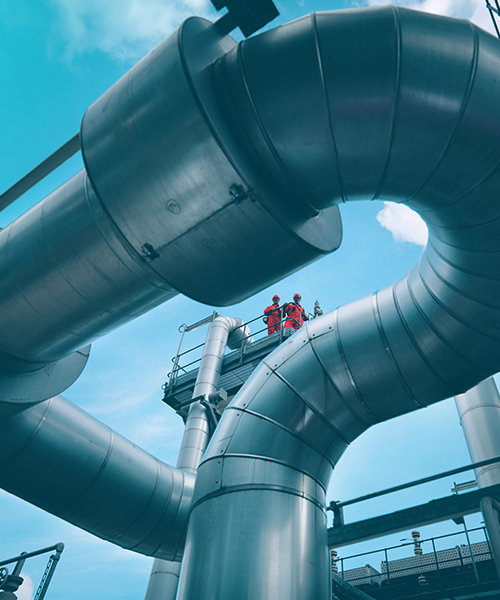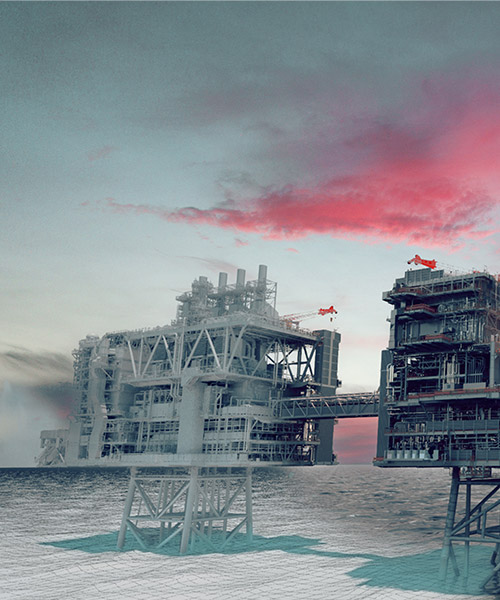April 14, 2022 • 5 min read
Digital twins: How virtual facilities can improve sustainability performance
What is digital twin technology and why is it important for digital transformation?
You’ve probably heard of digital twins before. However, the concept of digital twins is often surrounded by hype, while multiple definitions can cloud exactly what it is and why it’s important. But when we strip back the buzzwords, we find a compelling technology that can help us make better decisions, save costs, improve operational efficiency, and reduce carbon emissions.
What is a digital twin?
A digital twin is a virtual replica of an industrial facility, building or piece of equipment. Digital twins only exist in the virtual world, but they help us to visualize, monitor and improve the real thing. Or if the facility doesn’t exist yet, we can create a digital twin to help design for the most effective operations in the real-world.
We can create a digital twin for a single physical asset, such as an offshore platform. And we can also build digital twins for distributed assets, such as wind and solar farms, or mine sites.
For example, if our customer operates a wind farm and wants to use data to improve reliability, we use a structured data approach to create a digital twin, capturing everything from the shape of the wind turbine blades to the slope of the terrain. Industrial internet of things (IIOT) sensors connected to the real-world equipment capture thousands of items of data to create a live virtual model. This becomes a functional digital twin.
Digital twins also have an important role to play in improving sustainability in the energy, chemical and resources industries. From an environmental perspective, by monitoring environmental impacts of a facility over time, and from a safety perspective, by monitoring worker risk factors and providing insights that help to reduce them.
The benefits of digital twins
Digital twins bring value across the life of an asset. They have the power to change the way we engineer, operate, maintain, and interact with assets.
During engineering design and build phases, it can improve efficiency by centralizing information into a single source of truth and making information instantly accessible. Engineers and other project stakeholders can access accurate and complete engineering information where and when it’s needed.
Using data visualizations, and virtual reality models connected to engineering documentation, users can interact with their design to understand how it will function in the real world – from the complexity of the asset’s performance, to the practicalities of how workers navigate the site and access different pieces of equipment.
During operations, maintenance and modifications phases it helps to integrate work processes, and improve decision making through advanced analytics, process simulation and optimization, and information governance.
Using real-time data, our experts can monitor equipment performance, identify problems and propose improvements from anywhere in the world. We can run simulations using our digital twin to see how the real-world facility would respond in different scenarios, such as increasing the load on a pump, or identifying which components would fail in extreme heat or cold.
These scenarios help us to predict the likely future outcome without having to take any risks or disrupt production processes on an operational facility. This means we can engineer solutions more quickly, and when we do need to perform maintenance, formulate the best approach to minimize downtime.
We can also benefit from using augmented reality in an operations digital twin. This technology allows field workers to interact with virtual data overlaid with what they see in the physical environment. And using a wearable device a field worker can broadcast what they see in the real environment to experts working remotely. It makes it possible to inspect problems and develop solutions without having to mobilize entire teams of experts to the facility. This improves reaction speed, reduces travel costs, transport emissions and the safety risk associated with visiting a physical industrial site.
How to make a digital twin
Capturing value from a digital twin requires a clear and value-driven strategy, expert implementation, and ongoing operations support.
1. Determine a specific use case for a digital twin
The starting point for any digital twin is to determine the specific challenge or issue that the digital twin will resolve. This focused approach helps to avoid creating a digital illusion, where too broad a scope with undefined parameters can lead to underwhelming outcomes or immeasurable value.
2. Create a strong asset data foundation
Attention then turns to the data readiness and digital readiness of the organization or the facility. Typically, data will be produced by many sources and accessed in an inconsistent and unstructured way. So it’s vital to create organized and structured data to bring clarity from this data complexity. It’s important to consider the complete life of the facility and ensure that quality and industry standards are applied to reduce risk and manage compliance.
3. Serve the end user with meaningful data visualizations
Finally, before implementation and operation, we need to consider how to use this structured data, and how it will be best served to the end user in a way that will help them to overcome the challenge they face. This includes the selection of key digital technologies and technology partners that will help to deliver meaningful visualizations. But it should also include a rigorous project and change management plan to ensure that the technology is well embedded and utilized effectively when it’s used in the live environment.
Why digital twin infrastructure is key to our future sustainability
It can be difficult to grasp how a virtual model can help increase efficiency and output, reduce carbon emissions or prevent environmental accidents. However, digital twins can do all those things.
For example, a simulation-based digital twin can help identify inefficient processes at a petrochemicals complex. We can simulate adjustments to those production processes to increase facility output with less energy or less feedstock. And then we can apply these learnings to increase the efficiency of every future facility.
Or in the case of an offshore wind farm, if predictive maintenance analysis produced by the digital twin suggests an item of equipment requires less maintenance than previously thought, we don’t need to send personnel long distances in a helicopter or a ship to check the physical object as often. On the other hand, if the digital twin suggests the equipment will fail sooner than we thought, we can address it and minimize unplanned shutdown of a vital source of renewable energy.
These scenarios apply across all industrial settings, from a copper processing plant to an offshore platform to an electrolyzer producing green hydrogen.
The future of digital twins
We can push digital twins even further. When we integrate technologies such as machine learning and artificial intelligence (AI) into the digital twin strategy, it can help to identify issues before engineers or on-site personnel can see them. In some cases, it can identify patterns in data that are completely invisible to the human eye and even propose its own solutions to problems.
As our industries shift toward standardized equipment and a simpler supply chain, digital twins will also become more accessible. For example, for design-one, build-many project types, or other standardized assets, if we design, pre-fabricate, and install identical modules, we can embed the same digital twin technology from the start, without needing to create a bespoke design for each module or operator.
Digital twins are not just important to the future of our industries, they’ve vital. They don’t generate electricity, refine raw materials, or turn waste into chemicals, but the insights digital twins offer about their real-world counterparts are already changing the world.



